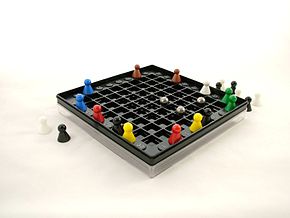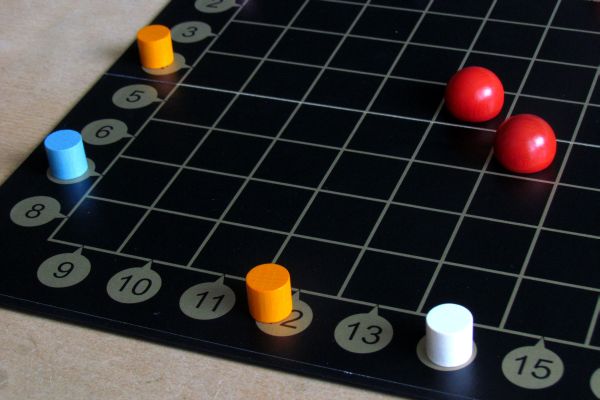Black Box (game)
Black Box is the name of a logic game by Eric Solomon. It appeared in 1976 at the Publisher Waddington and then at Parker Brothers as a black box. In 1978 it was sold by Parker Brothers in Germany as a logo, but was renamed at the instigation of Lego in Ordo. In the Netherlands Clipper as co- Code ( Kogeltjes code) it was sold. 1990 saw the game as a black box with the game publisher Franjos.
Milton Bradley and Jumbo brought each a game Black Box on the market. But here are other games.
Game Description
Black Box is related to " super-brain " ( mastermind ): Just like there must be one of the players only correct answer ( and doing a computer more reliable than a human). It plays a man against a computer. The description here is a computer program with ASCII graphics from the year 1986 ( source code and executables. Exe file, see Related links).
Where a board having eight columns ( a to h) and eight rows (1 to 8), ie 8 x 8 arrays of A1 to H8. The calculator uses four or five identical game pieces on random places, invisible to the player. The stones determine the possible paths on the game board. The player calls in each train the computer to the beginning of a journey into the game board into ( one out of 32 possible: north a to h, East 1-8, South a to h, West 1-8 ) and learns as an answer only where the path the board again leaves (another of these 32 outer edges of fields) or as the path on the board ends ( "hit" or " accident "). From the answers to as few questions is to infer the location of the stones.
Deductive approach
The player will now advise the location of the stones. Each question costs one or two points each at the end incorrectly guessed stone costs five points. The aim of the game is to keep the total number of points per game as low as possible. The player is set after a few responses on a trial basis some stones on the board. The calculator displays every time the board with all previous answers and test set stones. He marked those answers with call sign that are not compatible with the trial set stones. When the player is satisfied with his trial setting, he can leave as a tip. The computer then compares the tip with the real situation of the hidden stones and asks back if the tip can not be right. At the end of the game he adds the mentioned five points for each stone wrongly guessed.
The player may ask for ways to test set stones and leave their tip. Questions is, call the starting point of a path, ie, an input from the west or east in a row ( 1 through 8 ) or from North or South in a column (a.. H). There are exactly 32 possible questions.
The location of the stones determines the possible paths on the game board. If a path leads exactly to a stone, the calculator displays a hit ( T). Where an immediate way past a stone, so he bends away from the stone just before it reaches the height of the stone. So a continuous way you can not view, has the side from which the player asks him.
Examples
Here is an example:
.. I. . . . I. . . . I. . . . ' ---. 9th. . . . . . . The Nine (9 ) denotes the position of the stone, ' - marks the kink, the characters I and - mark the path, dots mark the other fields. ( The trail is marked only here in this one example, the kinks are shown only in open play.)
For each question, the computer traces a path over the board and answers on the edge of the board where the road leaves the board again or how the road ends on the board. ( By the time you develop the necessary billiard look for it. )
Sample set is, place a number of suspected stones or take back.
Discharging is called the sample - placement make them binding. The computer then sets star where the stones were hidden.
A question consists of a letter for the direction from which the path has to go into the field, and the name of the row or column, ie Na .. Nh, O1 .. O8, Sa .. Sh or W1 .. W8.
The border of the playing field on the screen is exactly these names of all 32 possible questions. Immediately outside this boundary, the computer recorded the answers. Each answer consists of similar specification, where the road leaves the pitch again, or from a T ( for hit ) or a U ( for accident), plus a call sign, if the answer makes it necessary to reconsider the previous tip.
Once the player can guess the location of a stone, he will tell the computer: The player taps the assumed position and a number between 1 (very uncertain) and 9 ( safe), eg e31 e49 e3 and e4 for the positions. What number of players selected, only Wish value for him, but no effect on the game. - Take a sample piece already gone by any character other than 1 .. 9 to type behind the position, for example, a space ( not here) or a question mark ( for later review ).
The path is determined as follows:
- As long as no stone is in the way and no tile on a field that is immediately adjacent to the path, the path leads straight ahead.
- If the next field blank, but the field is left ahead of busy, and right ahead is not occupied space, then bends to the point the way to the right by.
- Same as b, but right and left changed.
- If the path leaves the board, the machine at both ends of the path signals, the respective other end.
Example (where "9" is a stone, when a comma or apostrophe bends one way ):
Nb Nd Nf Ng ⇐ here are answers! Na Nb Nc Nd Ne Nf Ng Nh 12 So far points W8. ' -. - '. '-'. O8 W7 9th. . 9th. 9 O7 (N = North, O = East, S = South, W = West) W6. , -. -, ., -, . O6 O5 W5. . . . . . . . O5 W5 ( this road goes straight, but O4 W4. - '. ' -. . . . O4 W4 ... this only apparently. ) W3.. 9th. . . . O3 ( Sb -W2 bent only once, but Sb W2. -, .. . ' -. . O2 Sg ... this path bends three times. ) W1.. . . 9th. . O1 Sa Sb Sc Sd Se Sf Sg Sh ( Unfortunately shows the comma in b6 not exactly W2 O2 on the apostrophe in b4. ) Is the next field occupies in the direction of the path, then notify the computer a hit ( T), and the trail ends. Is free the next field, but the two boxes on the left forward and right ahead are busy, then the computer reports an accident (U), and the trail ends. If on entering the field, the first field -free, but the left and right pre- occupied at least one of the two fields ahead, then the calculator also reports an accident (U).
Example:
T U T A T T Na Nb Nc Nd Ne Nf Ng Nh 24 So far points T W8. . 9th. . . . O8 T W7. . . , -. . . . O7 U ⇐ accident in d6. W6. . . . . . . . O6 T W5. . 9th 9th. . O5 T W4. . . . . , -. . T ⇐ O4 O4 meets a2. U W3.. . . . . . . O3 T W2 9th. . . - '. . O2 U W1., -. . . . 9th O1 T Sa Sb Sc Sd Se Sf Sg Sh ( All hits and accidents TTTUTUTU are registered. ) rating
Hits and accidents cost one point each. Any other way is somewhere out again, provides answers to two questions and, therefore, costs two points. A question can thus cost a point or two points. Everyone guessed wrong stone costs five points.
You can always check the score indicated as follows: Each reply memorandum on the edge costs one point, and when the game is over, come for each stone misplaced added five points. If too few or too many stones were set, applies either the number of the set to the wrong location or the number of not taken stones, depending on which of the two numbers is greater. Can not or will not locate all the tiles you, so you therefore advises the last stones; you save anything, if you put less stones than are to be found.
With experience and a lot of care an average of 16 points can be reached with five stones. In the best case lies with five response points out the position of all five stones; In the worst case, the fifth stone may be on a six or maybe even more places to hide so that no question reached him.










